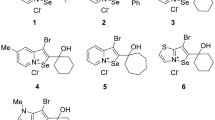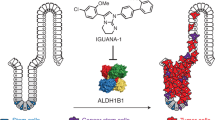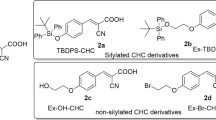Abstract
Catalytic anticancer metallodrugs active at low doses could minimize side-effects, introduce novel mechanisms of action that combat resistance and widen the spectrum of anticancer-drug activity. Here we use highly stable chiral half-sandwich organometallic Os(II) arene sulfonyl diamine complexes, [Os(arene)(TsDPEN)] (TsDPEN, N-(p-toluenesulfonyl)-1,2-diphenylethylenediamine), to achieve a highly enantioselective reduction of pyruvate, a key intermediate in metabolic pathways. Reduction is shown both in aqueous model systems and in human cancer cells, with non-toxic concentrations of sodium formate used as a hydride source. The catalytic mechanism generates selectivity towards ovarian cancer cells versus non-cancerous fibroblasts (both ovarian and lung), which are commonly used as models of healthy proliferating cells. The formate precursor N-formylmethionine was explored as an alternative to formate in PC3 prostate cancer cells, which are known to overexpress a deformylase enzyme. Transfer-hydrogenation catalysts that generate reductive stress in cancer cells offer a new approach to cancer therapy.
This is a preview of subscription content, access via your institution
Access options
Access Nature and 54 other Nature Portfolio journals
Get Nature+, our best-value online-access subscription
$29.99 / 30 days
cancel any time
Subscribe to this journal
Receive 12 print issues and online access
$259.00 per year
only $21.58 per issue
Buy this article
- Purchase on Springer Link
- Instant access to full article PDF
Prices may be subject to local taxes which are calculated during checkout



Similar content being viewed by others
References
Mjos, K. D. & Orvig, C. Metallodrugs in medicinal inorganic chemistry. Chem. Rev. 114, 4540–4563 (2014).
Florea, A.-M. & Büsselberg, D. Cisplatin as an anti-tumor drug: cellular mechanisms of activity, drug resistance and induced side effects. Cancers 3, 1351–1371 (2011).
Ward, T. R. Artificial metalloenzymes based on the biotin−avidin technology: enantioselective catalysis and beyond. Acc. Chem. Res. 44, 47–57 (2011).
Dougan, S. J., Habtemariam, A., McHale, S. E., Parsons, S. & Sadler, P. J. Catalytic organometallic anticancer complexes. Proc. Natl Acad. Sci. USA 105, 11628–11633 (2008).
Soldevila-Barreda, J. J., Romero-Canelón, I., Habtemariam, A. & Sadler, P. J. Transfer hydrogenation catalysis in cells as a new approach to anticancer drug design. Nat. Commun. 6, 6582 (2015).
Liu, Z. et al. The potent oxidant anticancer activity of organoiridium catalysts. Angew. Chem. Int. Ed. 53, 3941–3946 (2014).
Fu, Y. et al. The contrasting chemical reactivity of potent isoelectronic iminopyridine and azopyridine osmium(II) arene anticancer complexes. Chem. Sci. 3, 2485–2494 (2012).
Sasmal, P. K., Streu, C. N. & Meggers, E. Metal complex catalysis in living biological systems. Chem. Commun. 49, 1581–1587 (2013).
Völker, T., Dempwolff, F., Graumann, P. L. & Meggers, E. Progress towards bioorthogonal catalysis with organometallic compounds. Angew. Chem. Int. Ed. 53, 10536–10540 (2014).
Tomás-Gamasa, M., Martínez-Calvo, M., Couceiro, J. R. & Mascareñas, J. L. Transition metal catalysis in the mitochondria of living cells. Nat. Commun. 7, 12538 (2016).
Hsu, H.-T., Trantow, B. M., Waymouth, R. M. & Wender, P. A. Bioorthogonal catalysis: a general method to evaluate metal-catalyzed reactions in real time in living systems using a cellular luciferase reporter system. Bioconjugate Chem. 27, 376–382 (2016).
Jeschek, M. et al. Directed evolution of artificial metalloenzymes for in vivo metathesis. Nature 537, 661–665 (2016).
Coriat, R. et al. The organotelluride catalyst LAB027 prevents colon cancer growth in the mice. Cell Death Dis. 2, e191 (2011).
Yu, Z., Han, M. & Cowan, J. A. Toward the design of a catalytic metallodrug: selective cleavage of G-quadruplex telomeric DNA by an anticancer copper–acridine–ATCUN complex. Angew. Chem. Int. Ed. 54, 1901–1905 (2015).
Soldevila-Barreda, J. J., Habtemariam, A., Romero-Canelón, I. & Sadler, P. J. Half-sandwich rhodium(III) transfer hydrogenation catalysts: reduction of NAD+ and pyruvate, and antiproliferative activity. J. Inorg. Biochem. 153, 322–333 (2015).
Okamoto, Y., Köhler, V., Paul, C. E., Hollmann, F. & Ward, T. R. Efficient in situ regeneration of NADH mimics by an artificial metalloenzyme. ACS Catal. 6, 3553–3557 (2016).
Dürrenberger, M. et al. Artificial transfer hydrogenases for the enantioselective reduction of cyclic imines. Angew. Chem. Int. Ed. 50, 3026–3029 (2011).
Collot, J. et al. Artificial metalloenzymes for enantioselective catalysis based on biotin−avidin. J. Am. Chem. Soc. 125, 9030–9031 (2003).
Hashiguchi, S., Fujii, A., Takehara, J., Ikariya, T. & Noyori, R. Asymmetric transfer hydrogenation of aromatic ketones catalyzed by chiral ruthenium(II) complexes. J. Am. Chem. Soc. 117, 7562–7563 (1995).
Fujii, A., Hashiguchi, S., Uematsu, N., Ikariya, T. & Noyori, R. Ruthenium(II)-catalyzed asymmetric transfer hydrogenation of ketones using a formic acid−triethylamine mixture. J. Am. Chem. Soc. 118, 2521–2522 (1996).
Haack, K.-J., Hashiguchi, S., Fujii, A., Ikariya, T. & Noyori, R. The catalyst precursor, catalyst, and intermediate in the Ru(II)-promoted asymmetric hydrogen transfer between alcohols and ketones. Angew. Chem. Int. Ed. 36, 285–288 (1997).
Noyori, R. & Hashiguchi, S. Asymmetric transfer hydrogenation catalyzed by chiral ruthenium complexes. Acc. Chem. Res. 30, 97–102 (1997).
Coverdale, J. P. C. et al. Easy to synthesize, robust organo–osmium asymmetric transfer hydrogenation catalysts. Chem. Eur. J. 21, 8043–8046 (2015).
Liu, Z. et al. Organometallic half-sandwich iridium anticancer complexes. J. Med. Chem. 54, 3011–3026 (2011).
Ling, B. et al. D-Lactate altered mitochondrial energy production in rat brain and heart but not liver. Nutr. Metab. 9, 6 (2012).
Hirschhaeuser, F., Sattler, U. G. A. & Mueller-Klieser, W. Lactate: a metabolic key player in cancer. Cancer Res. 71, 6921–6925 (2011).
Doherty, J. R. & Cleveland, J. L. Targeting lactate metabolism for cancer therapeutics. J. Clin. Invest. 123, 3685–3692 (2013).
Koukourakis, M. I. et al. Lactate dehydrogenase 5 expression in squamous cell head and neck cancer relates to prognosis following radical or postoperative radiotherapy. Oncology 77, 285–292 (2009).
Koukourakis, M. I. et al. Lactate dehydrogenase-5 (LDH-5) overexpression in non-small-cell lung cancer tissues is linked to tumour hypoxia, angiogenic factor production and poor prognosis. Br. J. Cancer 89, 877–885 (2003).
Hileman, E. O., Liu, J., Albitar, M., Keating, M. J. & Huang, P. Intrinsic oxidative stress in cancer cells: a biochemical basis for therapeutic selectivity. Cancer Chemother. Pharmacol. 53, 209–219 (2004).
Pennington, J. D. et al. Redox-sensitive signaling factors as a novel molecular targets for cancer therapy. Drug Resist. Update 8, 322–330 (2005).
Peacock, A. F. A. et al. Tuning the reactivity of osmium(II) and ruthenium(II) arene complexes under physiological conditions. J. Am. Chem. Soc. 128, 1739–1748 (2006).
Wang, F. et al. Controlling ligand substitution reactions of organometallic complexes: tuning cancer cell cytotoxicity. Proc. Natl Acad. Sci. USA 102, 18269–18274 (2005).
Bruijnincx, P. C. A. & Sadler, P. J. Controlling platinum, ruthenium and osmium reactivity for anticancer drug design. Adv. Inorg. Chem. 61, 1–62 (2009).
Lau, J. K.-C. & Ensing, B. Hydrolysis of cisplatin—a first-principles metadynamics study. Phys. Chem. Chem. Phys. 12, 10348–10355 (2010).
Needham, R. J. et al. In-cell activation of organo–osmium(II) anticancer complexes. Angew. Chem. Int. Ed. 56, 1017–1020 (2017).
Hoeferlin, L. A., Oleinik, N. V., Krupenko, N. I. & Krupenko, S. A. Activation of p21-dependent G1/G2 arrest in the absence of DNA damage as an antiapoptotic response to metabolic stress. Genes Cancer 2, 889–899 (2011).
Dasari, S. & Tchounwou, P. B. Cisplatin in cancer therapy: molecular mechanisms of action. Eur. J. Pharmacol. 740, 364–378 (2014).
Ewaschuk, J. B., Naylor, J. M. & Zello, G. A. D-Lactate in human and ruminant metabolism. J. Nutr. 135, 1619–1625 (2005).
Yamakawa, M., Yamada, I. & Noyori, R. CH/π attraction: the origin of enantioselectivity in transfer hydrogenation of aromatic carbonyl compounds catalyzed by chiral η6-arene-ruthenium(II) complexes. Angew. Chem. Int. Ed. 40, 2818–2821 (2001).
Brandt, P., Roth, P. & Andersson, P. G. Origin of enantioselectivity in the Ru(arene)(amino alcohol)-catalyzed transfer hydrogenation of ketones. J. Org. Chem. 69, 4885–4890 (2004).
Dub, P. A. & Ikariya, T. Quantum chemical calculations with the inclusion of nonspecific and specific solvation: asymmetric transfer hydrogenation with bifunctional ruthenium catalysts. J. Am. Chem. Soc. 135, 2604–2619 (2013).
Dub, P. A. & Gordon, J. C. The mechanism of enantioselective ketone reduction with Noyori and Noyori–Ikariya bifunctional catalysts. Dalton Trans. 45, 6756–6781 (2016).
Handgraaf, J.-W. & Meijer, E. J. Realistic modeling of ruthenium-catalyzed transfer hydrogenation. J. Am. Chem. Soc. 129, 3099–3103 (2007).
Bligh, C. M., Anzalone, L., Jung, Y. C., Zhang, Y. & Nugent, W. A. Preparation of both C5′ epimers of 5′-C-methyladenosine: reagent control trumps substrate control. J. Org. Chem. 79, 3238–3243 (2014).
Latham, T. et al. Lactate, a product of glycolytic metabolism, inhibits histone deacetylase activity and promotes changes in gene expression. Nucleic Acids Res. 40, 4794–4803 (2012).
Vichai, V. & Kirtikara, K. Sulforhodamine B colorimetric assay for cytotoxicity screening. Nat. Protocols 1, 1112–1116 (2006).
Venzago, C., Popp, M., Kovac, J. & Kunkel, A. Pharmacopeial requirements for elemental impurities: a novel approach to the trace determination of osmium by oxidative pressure vessel sample digestion and measurement using inductively coupled plasma mass spectrometry (ICP-MS) after complexation and stabilisation. J. Anal. At. Spectrom. 28, 1125–1129 (2013).
Acknowledgements
We thank the European Research Council (grant no. 247450 and no. 324594), Science City (Advantage West Midlands and the European Regional Development Fund), Warwick Collaborative Postgraduate Research Scholarship and Bruker Daltonics (studentship for J.P.C.C.), Engineering and Physical Research Council/Cancer Research UK (grant no. C53561/A19933) for support, and EU COST Action CM1105 for stimulating discussions. Some reduced precursors for dimer synthesis were kindly provided by K. T. Bhayat and R. Needham. We thank L. Song and P. Aston for assistance with mass spectrometry, A. Knight, H. E. Bridgewater and J. I. Song for assistance with cell experiments and I. Prokes for assistance with NMR spectroscopy.
Author information
Authors and Affiliations
Contributions
All the authors were involved with the design and interpretation of the experiments and with the writing of the manuscript. Chemical and biological experiments were carried out by J.P.C.C., I.R.-C., C.S.-C. and A.H. G.J.C. carried out the X-ray crystallography. All the authors have given approval to the final version of the manuscript.
Corresponding author
Ethics declarations
Competing interests
The authors declare no competing financial interests.
Supplementary information
Supplementary information
Supplementary information (PDF 2965 kb)
Supplementary information
Crystallographic data for compound RR-7. (CIF 1656 kb)
Supplementary information
Crystallographic data for compound SS-7. (CIF 1132 kb)
Supplementary information
Life Sciences Reporting Summary (PDF 73 kb)
Rights and permissions
About this article
Cite this article
Coverdale, J., Romero-Canelón, I., Sanchez-Cano, C. et al. Asymmetric transfer hydrogenation by synthetic catalysts in cancer cells. Nature Chem 10, 347–354 (2018). https://doi.org/10.1038/nchem.2918
Received:
Accepted:
Published:
Issue Date:
DOI: https://doi.org/10.1038/nchem.2918
This article is cited by
-
Metal complex catalysts broaden bioorthogonal reactions
Science China Chemistry (2024)
-
Nanocompartment-confined polymerization in living systems
Nature Communications (2023)
-
Targeting cancer lactate metabolism with synergistic combinations of synthetic catalysts and monocarboxylate transporter inhibitors
JBIC Journal of Biological Inorganic Chemistry (2023)
-
Perturbing tumor cell metabolism with a Ru(II) photo-redox catalyst to reverse the multidrug resistance of lung cancer
Science China Chemistry (2023)
-
Bioorthogonal catalytic patch
Nature Nanotechnology (2021)




